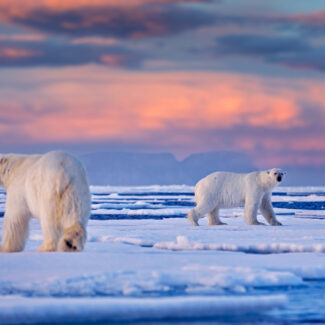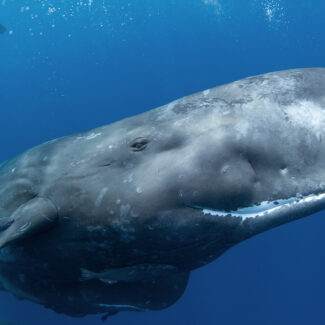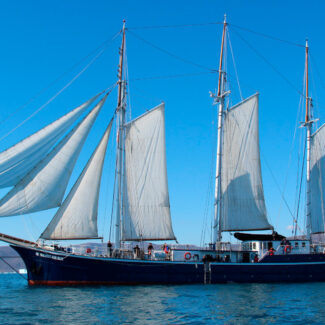Shackleton Endurance Expedition & Voyage Of The James Caird
Ernest Shackleton’s 1914-1917 Imperial Trans-Antarctic Expedition did not achieve close to what it set out to accomplish. Yet it stands firmly as one of the greatest survival and seafaring stories in history, cementing Shackleton’s status as a truly iconic leader. There may be no better-known or more astonishing story from the Heroic Age of Antarctic Exploration, and that’s saying something!
The Backstory: Shackleton’s Previous Antarctic Endeavors
Irish-born Ernest Shackleton had become a sub-lieutenant in the British Royal Navy in 1901, and that year served on Robert Falcon Scott’s National Antarctic Expedition. This influential three-year operation, based out of Hut Point on McMurdo Sound, gathered a huge amount of scientific data and charted plenty of new territory. It also notched such firsts as the discovery of an emperor penguin colony and the pioneering trek onto the Antarctic Polar Plateau, a journey undertaken by Scott, Shackleton, and Edward A. Wilson.
Building on this experience, Shackleton returned to Antarctica in 1907, this time as the leader of his own British Antarctic Expedition aboard the Nimrod. Through 1909, he and his men made numerous strides in the exploration of the White Continent out of their hut at Cape Royds, McMurdo Sound.
Among those accomplishments were summiting the mighty volcano Mount Erebus for the first time, discovering the Beardmore Glacier as a portal onto the Polar Plateau, and, in reaching 88 degrees 23 minutes latitude on that high ice-sheet surface, not only going the farthest south yet achieved but also trekking the closest to either of Earth’s geographic poles.
Antarctica’s history is full of daring expeditions, some ending in famous shipwrecks. Yet, the resilience and determination of explorers, like those pictured, continue to inspire awe. Their stories remind us of the immense challenges and indomitable human spirit in this frozen wilderness.
Source: J. B. Adams, Public domain, via Wikimedia Commons
The Imperial Trans-Antarctic Expedition
In the austral summer of 1911-1912, the Norwegian explorer Roald Amundsen became the first person to reach the South Pole—beating by more than a month Robert Falcon Scott’s polar party, doomed to perish on the return route.
Shackleton had himself tried for the pole during his 1907-1909 expedition, and his Beardmore Glacier route onto the Polar Plateau was followed by Scott and his men. Amundsen’s achievement only bolstered Shackleton’s enthusiasm for the next great feat to be tried on the White Continent. As he wrote, “The discovery of the South Pole will not be an end to Antarctic exploration. The next work is a transcontinental journey, from sea to sea, crossing the pole.”
What Shackleton ultimately conceived for the Imperial Trans-Antarctic Expedition was a transect of the White Continent from Vahsel Bay on the Luitpold Coast of Coats Land, reached via the Weddell Sea, over the South Pole to the Ross Sea.
He envisioned his party tackling the transcontinental trek, with another team, the Ross Sea Party, sailing separately to McMurdo Sound and laying out supply depots across the Ross Ice Shelf to the Beardmore Glacier for Shackleton’s group to later utilize on the final leg of their journey.
The Shackleton expedition party sailed in the Endurance, named after the Shackleton family motto (“By endurance we conquer”). The Ross Sea Party used an old whaling ship turned exploratory vessel, the Aurora, which had been employed under the great Australian explorer Douglas Mawson during the 1911-1914 Australasian Antarctic Expedition. (Mawson had been on Shackleton’s crew for the Nimrod expedition.)
The Endurance set forth out of Plymouth on August 8, 1914—only a few days after Great Britain declared war on Germany. That news had inspired Shackleton to offer the Endurance and its crew to the war effort, but First Lord of the Admiralty Winston Churchill gave him the go-ahead to proceed with his Antarctic efforts.
Sailing Into the Ice
On November 5, 1914, the Endurance pulled into port at Grytviken, the roughly decade-old South Georgia whaling station. There, Shackleton was informed of unusually severe ice conditions in the Weddell Sea, but nonetheless was determined to continue onward.
Leaving South Georgia on December 5, the Endurance encountered its first pack ice two days later. By December 11, the ship was maneuvering through what was now a thick and extensive pack—thicker and more extensive than Shackleton had hoped for, certainly. Progress was slow, but by January 10, 1915, the mainland coast of Coats Land could be seen.
On January 18—only about 80 miles from their goal of Vahsel Bay, and having sighted and named the Caird Coast linking Coats Land and the Luitpold Coast—the Endurance became trapped in the pack ice.
Shackleton’s Endurance sailed bravely into the treacherous Weddell Sea, only to be ultimately crushed by the ice. This iconic image captures the dramatic moment of its demise, foreshadowing the epic survival saga that would define this legendary expedition.
The Icebound Endurance
Thus began the first great trial of the Imperial Trans-Antarctic Expedition, as the ice-locked Endurance with its crew began drifting with the pack. Tantalizingly close as the ship had been to the intended landing site, Shackleton determined that manhauling all of their supplies over the rough and treacherous sea ice was unfeasible. After efforts to free the Endurance proved futile, Shackleton decided the crew would have to resign itself to overwintering on the pack ice with the ship.
In October of 1915, after many months of entrapped drifting, the Endurance began buckling as pressure ridges formed in the pack ice. The ship was crushed, tilted, and heaved upward. Deeming the ravaged vessel too dangerous, Shackleton ordered the men to move into tents on the ice, thereby establishing Ocean Camp.
Minimal possessions were retrieved from the doomed Endurance; expedition photographer Frank Hurley made a heroic trip into the ship to rescue his glass plates. He and Shackleton chose 120 of those plates to preserve, then smashed another 400-odd of them to avoid Hurley having second thoughts later and trying to retrieve them.
On November 21, the partly crushed and leaking Endurance finally went down under the icy waters of the Weddell Sea. The crew moved from Ocean Camp to a new site, Patience Camp, resolving to wait for the ice to break up. This they did for another five or so months, by the end of which they’d drifted some 2,000 miles and were northeast of the tip of the Antarctic Peninsula.
Discovered over a century after its sinking, the Endurance rests preserved in the icy depths of the Weddell Sea. This incredible sight, revealing its nameplate, offers a profound connection to Shackleton’s epic tale of survival and the enduring power of the Antarctic wilderness. Source: Endurance22, CC BY-SA 4.0 <https://creativecommons.org/licenses/by-sa/4.0>, via Wikimedia Commons
Journey to Elephant Island
On April 9, 1916, the Endurance crew loaded themselves into the lost ship’s three lifeboats—the James Caird, the Stancomb Wills, and the Dudley Docker—and launched into the Southern Ocean. Shackleton’s goal was one of several small isles in the South Shetland Islands, and as the open-sea voyage proceeded he narrowed the choices down to Elephant Island.
This barren, farflung island the lifeboats reached on April 15, 1916, when the Endurance crew was able to set foot on terra firma for the first time in almost 500 days.
The Voyage of the James Caird to South Georgia
It must’ve been a relief to be on solid ground. But Elephant Island, the men knew, was remote and little-visited. There was no reason to expect a vessel to pass near anytime soon.
Experiencing just a portion of any one of the various legs of unplanned adventure the Endurance crew had, well, endured thus far would probably be enough for a lifetime. But Shackleton knew that actively seeking rescue, despite the party’s limited resources and haggard condition, was the only hope.
Evaluating the closest settlements at which to seek help, he decided South Georgia, while some 850 discouraging miles from Elephant Island, nonetheless offered the likeliest odds of reaching and mustering help. Thus the James Caird, the largest of the three lifeboats, was outfitted for a Hail-Mary-style voyage, the Endurance carpenter, Harry “Chippy” McNeish, raising the gunwales, rigging it with a mast from the Stancomb Wills, and installing a canvas cover to keep as much seawater out as possible.
Having first come ashore on Elephant Island at inhospitable Cape Valentine, the crew had trekked some nine miles away to a somewhat more sheltered gravel shore they named Cape Wild. From here, on Easter Monday April 24, 1916, Shackleton and five men he’d selected—Endurance Captain Frank Worsley as navigator as well as McNeish, Tom Crean, Tim MccCarthy, and John Vincent—shoved off into the rough surf in hopes of fetching help from faraway South Georgia.
This may well have been the most remarkable chapter of the entire remarkable Endurance saga. Enduring fierce gales, grabbing only fleeting views of the Sun by which to navigate, and dealing with the omnipresent threat of frostbite—and the knowledge that drifting off-course would doom not only the James Caird squad but the rest of the castaways back on Elephant Island—Shackleton and his companions somehow managed to reach South Georgia on May 10, after an improbable two-week voyage. Surely the James Caird’s open-water journey from Elephant Island to South Georgia ranks among the most momentous sea crossings of all time.
The incredible voyage of the James Caird, a tiny lifeboat, across 800 miles of stormy Southern Ocean is a testament to human courage. This replica inspires awe for Shackleton and his crew’s legendary perseverance against impossible odds, a true beacon of human spirit. Source: Liam Quinn from Canada, CC BY-SA 2.0 <https://creativecommons.org/licenses/by-sa/2.0>, via Wikimedia Commons
Crossing South Georgia
The James Caird came ashore on South Georgia’s uninhabited southern coastline, at King Haakon Bay. Shackleton was determined to reach the Norwegian whaling station of Stromness, which lay on the other side of the spectacularly rugged island.
Given the condition of the heroic lifeboat and the tricky coastline, Shackleton was sure an overland trek was the only way to reach Stromness. That required negotiating South Georgia’s interior mountains: severe, glacier-swept terrain that was barely known at the time. He enlisted the two companions of his in the best shape, Crean and Worsley, to accompany himself on this daring hike, which commenced on May 19.
How long did it take for Shackleton to cross South Georgia? He and his men made this first recorded traverse of the island’s interior in 36 hours, covering some 30 miles of incredibly demanding topography. The men walked into Stromness on May 20, welcomed warmly by the Norwegians.
Rescue Missions
At Stromness, a whaleship was dispatched (with Worsley aboard) to pick up the three men who’d stayed behind at King Haakon Bay. Meanwhile, Shackleton immediately set about planning a rescue mission to Elephant Island.
He embarked in a borrowed ship, the Southern Sky, with a volunteer crew, but they were turned back by pack ice. Ice also thwarted two subsequent rescue voyages in different ships.
Finally, in August of 1916, the Chilean Navy lent him a tug, the Yelcho, commanded by Captain Luis Pardo, which was able to reach Elephant Island on the 30th and rescue all remaining 22 men of the Endurance expedition, who’d survived on their bleak outpost for more than three months after the James Caird set sail.
Amazingly, despite the enormous hardships and incredibly steep odds, all of the crew of the Endurance survived their ordeal.
The rescue at Elephant Island wasn’t even the end of the whole saga, as Shackleton still had to arrange for the retrieval of the Ross Sea Party, which had fulfilled its mission of laying supply depots for Shackleton’s party and endured its own terrible tribulations (with several lives lost). The remaining members of the Ross Sea Party were rescued on January 10, 1917 by the Aurora, with Shackleton on board.
Marooned on desolate Elephant Island, Shackleton’s crew endured unimaginable hardship awaiting rescue. This image captures their grim wait, a powerful testament to human endurance and hope amidst extreme adversity, inspiring awe for their survival against all odds.
Aftermath & Legacy
Ernest Shackleton’s Imperial Trans-Antarctic Expedition became one of the defining events of the so-called Heroic Age of Antarctic Exploration. Many historians consider that era, begun in the late 19th century, to have closed with Shackleton’s death from heart attack in 1922 at Grytviken, South Georgia, where he was preparing to embark back to the White Continent with the Shackleton-Rowett Antarctic Expedition.
The goal of crossing Antarctica from coast to coast wouldn’t be realized for decades more, until the British Commonwealth Trans-Antarctic Expedition journeyed from the Filchner Ice Shelf (at Shackleton Base) to Ross Island between November 24, 1957 and March 2, 1958. (This expedition included on its support team Edmund Hillary, only a few years past making the first documented summit climb of Mount Everest with Tenzing Norgay.)
The Endurance remained lost at the bottom of the Weddell Sea for more than a hundred years, among the world’s most famous and sought-after shipwrecks. It wasn’t until 2022 that the vessel—in startlingly good condition—was located using underwater drones close to 10,000 feet down on the Weddell seafloor.
Despite its discovery, fascination with the Endurance‘s sinking endures. A recent study published in the Polar Record contends that the expedition was likely doomed long before it began given the ship lacked the requisite structural beams to withstand compression by ice—a flaw that Shackleton himself was aware of long before he launched to Antarctica.
That superlative lifeboat the James Caird, meanwhile, can be seen today: at Dulwich College in London, where the James Caird Society—founded in 1994 to celebrate Shackleton’s exploits and the Heroic Age of Antarctic Exploration—holds its twice-annual meetings.
Retracing the Endurance Expedition
From South Georgia and the South Shetlands to the penguin- and iceberg-plied waters of the Weddell Sea, you can trace part of the journey of Ernest Shackleton and the Endurance crew on an Antarctic sightseeing cruise. It never fails to boggle the mind when one considers—from the warmth, comfort, and safety of a modern-day cruise ship or expedition vessel, of course—what those Heroic Age explorers went through in such a vast, severe, and (yes) strikingly beautiful polar wilderness.
Disclaimer
Our travel guides are for informational purposes only. While we aim to provide accurate and up-to-date information, Antarctica Cruises makes no representations as to the accuracy or completeness of any information in our guides or found by following any link on this site.
Antarctica Cruises cannot and will not accept responsibility for any omissions or inaccuracies, or for any consequences arising therefrom, including any losses, injuries, or damages resulting from the display or use of this information.










